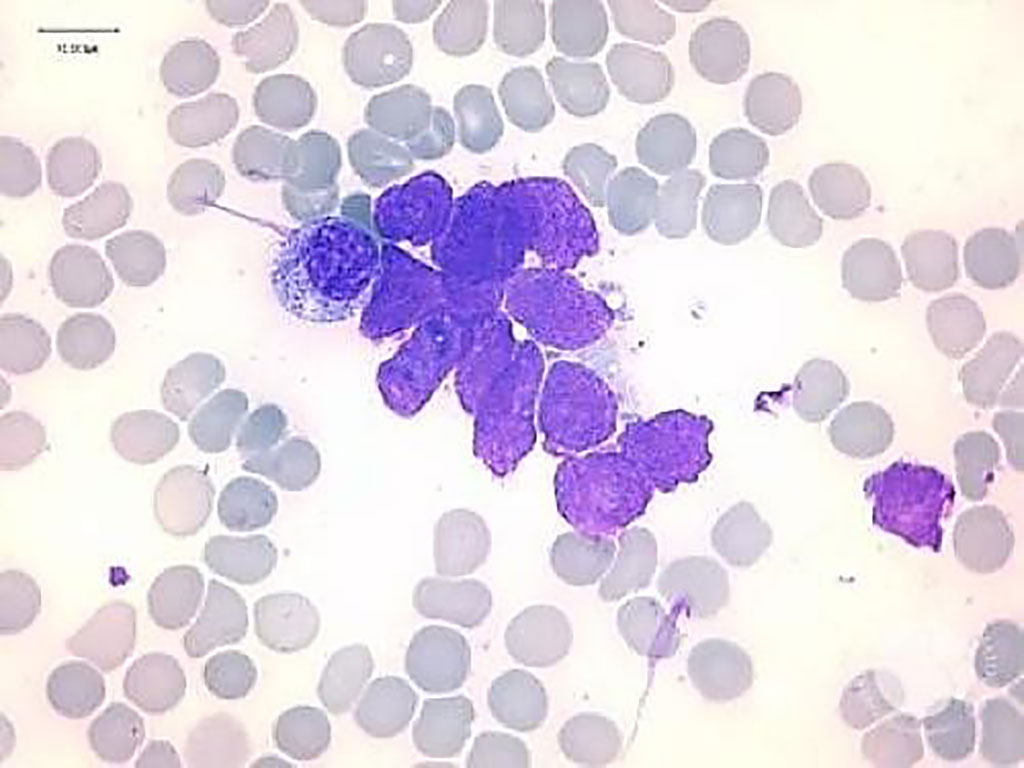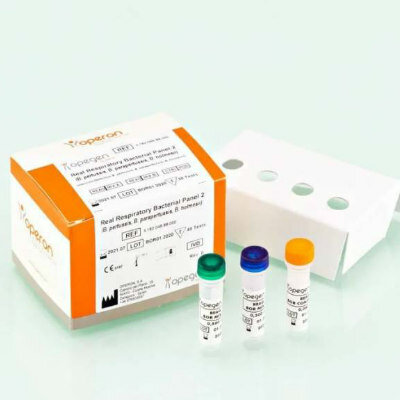Single-Cell Transcriptomic Analysis Traces Neuroblastomas to Developing Adrenal Neuroblasts
|
By LabMedica International staff writers Posted on 07 Apr 2021 |

Image: Bone marrow aspirate from a child with a mediastinal tumor shows an invasion with neuroblastoma cells and characteristic images of neuropile threads (Photo courtesy of Mohammed Bensalah, MD, Amina Lyagoubi, and Rachid Seddik)
Neuroblastoma is the most common cancer in infants and the third-most common cancer in children after leukemia and brain cancer. Approximately one in every 7,000 children is affected at some time and about 90% of cases occur in children less than five years old, and it is rare in adults.
Neuroblastoma is a type of cancer that forms in certain types of nerve tissue. It most frequently starts from one of the adrenal glands, but can also develop in the neck, chest, abdomen, or spine. Symptoms may include bone pain, a lump in the abdomen, neck, or chest, or a painless bluish lump under the skin.
Pediatric Oncologists at the Hopp Children's Cancer Center Heidelberg (Heidelberg, Germany) analyzed samples from 17 fresh-frozen developing human adrenal glands using droplet-based single-nucleus RNA-seq. These samples represented seven developmental time points ranging from seven weeks post-conception to 17 weeks post-conception. They clustered the cells and assigned them to major cell types based on the markers they expressed, but focused much of their analysis on adrenal medullary cells such as Schwann cell precursors, chromaffin cells, and neuroblasts.
By comparing these normal developing human adrenal gland cells to cells from 14 neuroblastomas also analyzed by single-nucleus RNA-seq, the team found that the tumors resembled differentiating adrenal neuroblasts and they also noticed some differences by tumor type. For instance, MYCN-amplified neuroblastoma cells were most similar to normal neuroblasts from seven or eight weeks post-conception, while lower-risk neuroblastomas included more cells resembling late neuroblasts. This suggested that low-risk tumors might develop from cells further along in the development and differentiation process. They confirmed this finding by projecting single neuroblastoma cells onto diffusion maps of normal adrenal medullary cells to again find neuroblastoma cells mapped to normal neuroblasts and that low-risk tumors were more similar to differentiated neuroblasts and high-risk ones to earlier-state neuroblasts. They additionally found that differentiation markers varied between high-risk and low-risk tumors.
The scientists then examine whether MYCN, often amplified among high-risk tumors, can suppress differentiation. In an inducible MYCN knock-down model of MYCN-amplified neuroblastoma cells, they found that elevated MYCN can induce de-differentiation and activate proliferation. At the same time, though, activating TFAP2B, a transcription factor that is highly expressed in normal neuroblasts but not in high-risk neuroblastomas, restores differentiation signatures.
The authors concluded that the identification of tumor-related transcriptional changes and molecular mechanisms underlying impaired differentiation may guide future studies on the functional evaluation of candidate genes, refined risk classification and generation of clinically relevant neuroblastoma models. Moreover, they have provided the framework to evaluate therapeutic concepts that are based on induction of differentiation. The study was published on March 25, 2021 in the journal Nature Genetics.
Related Links:
Hopp Children's Cancer Center Heidelberg
Neuroblastoma is a type of cancer that forms in certain types of nerve tissue. It most frequently starts from one of the adrenal glands, but can also develop in the neck, chest, abdomen, or spine. Symptoms may include bone pain, a lump in the abdomen, neck, or chest, or a painless bluish lump under the skin.
Pediatric Oncologists at the Hopp Children's Cancer Center Heidelberg (Heidelberg, Germany) analyzed samples from 17 fresh-frozen developing human adrenal glands using droplet-based single-nucleus RNA-seq. These samples represented seven developmental time points ranging from seven weeks post-conception to 17 weeks post-conception. They clustered the cells and assigned them to major cell types based on the markers they expressed, but focused much of their analysis on adrenal medullary cells such as Schwann cell precursors, chromaffin cells, and neuroblasts.
By comparing these normal developing human adrenal gland cells to cells from 14 neuroblastomas also analyzed by single-nucleus RNA-seq, the team found that the tumors resembled differentiating adrenal neuroblasts and they also noticed some differences by tumor type. For instance, MYCN-amplified neuroblastoma cells were most similar to normal neuroblasts from seven or eight weeks post-conception, while lower-risk neuroblastomas included more cells resembling late neuroblasts. This suggested that low-risk tumors might develop from cells further along in the development and differentiation process. They confirmed this finding by projecting single neuroblastoma cells onto diffusion maps of normal adrenal medullary cells to again find neuroblastoma cells mapped to normal neuroblasts and that low-risk tumors were more similar to differentiated neuroblasts and high-risk ones to earlier-state neuroblasts. They additionally found that differentiation markers varied between high-risk and low-risk tumors.
The scientists then examine whether MYCN, often amplified among high-risk tumors, can suppress differentiation. In an inducible MYCN knock-down model of MYCN-amplified neuroblastoma cells, they found that elevated MYCN can induce de-differentiation and activate proliferation. At the same time, though, activating TFAP2B, a transcription factor that is highly expressed in normal neuroblasts but not in high-risk neuroblastomas, restores differentiation signatures.
The authors concluded that the identification of tumor-related transcriptional changes and molecular mechanisms underlying impaired differentiation may guide future studies on the functional evaluation of candidate genes, refined risk classification and generation of clinically relevant neuroblastoma models. Moreover, they have provided the framework to evaluate therapeutic concepts that are based on induction of differentiation. The study was published on March 25, 2021 in the journal Nature Genetics.
Related Links:
Hopp Children's Cancer Center Heidelberg
Latest Molecular Diagnostics News
- Novel Autoantibody Against DAGLA Discovered in Cerebellitis
- Blood Test Could Identify Patients at Risk for Severe Scleroderma
- Gene-Based Blood Test Accurately Predicts Tumor Recurrence of Advanced Skin Cancer
- Rapid Blood Test Identifies Pre-Symptomatic Patients with Parkinson’s Disease
- Blood Test for Early Alzheimer's Detection Achieves Over 90% Accuracy
- RNA-Based Blood Test Detects Preeclampsia Risk Months Before Symptoms
- First Of Its Kind Test Uses microRNAs to Predict Toxicity from Cancer Therapy
- Novel Cell-Based Assay Provides Sensitive and Specific Autoantibody Detection in Demyelination
- Novel Point-of-Care Technology Delivers Accurate HIV Results in Minutes
- Blood Test Rules Out Future Dementia Risk
- D-Dimer Testing Can Identify Patients at Higher Risk of Pulmonary Embolism
- New Biomarkers to Improve Early Detection and Monitoring of Kidney Injury
- Chemiluminescence Immunoassays Support Diagnosis of Alzheimer’s Disease
- Blood Test Identifies Multiple Biomarkers for Rapid Diagnosis of Spinal Cord Injury
- Highly Accurate Blood Test Diagnoses Alzheimer’s and Measures Dementia Progression
- Simple DNA PCR-Based Lab Test to Enable Personalized Treatment of Bacterial Vaginosis
Channels
Clinical Chemistry
view channel
Low-Cost Portable Screening Test to Transform Kidney Disease Detection
Millions of individuals suffer from kidney disease, which often remains undiagnosed until it has reached a critical stage. This silent epidemic not only diminishes the quality of life for those affected... Read more
New Method Uses Pulsed Infrared Light to Find Cancer's 'Fingerprints' In Blood Plasma
Cancer diagnoses have traditionally relied on invasive or time-consuming procedures like tissue biopsies. Now, new research published in ACS Central Science introduces a method that utilizes pulsed infrared... Read moreHematology
view channel
New Scoring System Predicts Risk of Developing Cancer from Common Blood Disorder
Clonal cytopenia of undetermined significance (CCUS) is a blood disorder commonly found in older adults, characterized by mutations in blood cells and a low blood count, but without any obvious cause or... Read more
Non-Invasive Prenatal Test for Fetal RhD Status Demonstrates 100% Accuracy
In the United States, approximately 15% of pregnant individuals are RhD-negative. However, in about 40% of these cases, the fetus is also RhD-negative, making the administration of RhoGAM unnecessary.... Read moreImmunology
view channel
Stem Cell Test Predicts Treatment Outcome for Patients with Platinum-Resistant Ovarian Cancer
Epithelial ovarian cancer frequently responds to chemotherapy initially, but eventually, the tumor develops resistance to the therapy, leading to regrowth. This resistance is partially due to the activation... Read more
Machine Learning-Enabled Blood Test Predicts Immunotherapy Response in Lymphoma Patients
Chimeric antigen receptor (CAR) T-cell therapy has emerged as one of the most promising recent developments in the treatment of blood cancers. However, over half of non-Hodgkin lymphoma (NHL) patients... Read moreMicrobiology
view channel
Handheld Device Delivers Low-Cost TB Results in Less Than One Hour
Tuberculosis (TB) remains the deadliest infectious disease globally, affecting an estimated 10 million people annually. In 2021, about 4.2 million TB cases went undiagnosed or unreported, mainly due to... Read more
New AI-Based Method Improves Diagnosis of Drug-Resistant Infections
Drug-resistant infections, particularly those caused by deadly bacteria like tuberculosis and staphylococcus, are rapidly emerging as a global health emergency. These infections are more difficult to treat,... Read more
Breakthrough Diagnostic Technology Identifies Bacterial Infections with Almost 100% Accuracy within Three Hours
Rapid and precise identification of pathogenic microbes in patient samples is essential for the effective treatment of acute infectious diseases, such as sepsis. The fluorescence in situ hybridization... Read morePathology
view channel
Novel UV and Machine Learning-Aided Method Detects Microbial Contamination in Cell Cultures
Cell therapy holds great potential in treating diseases such as cancers, inflammatory conditions, and chronic degenerative disorders by manipulating or replacing cells to restore function or combat disease.... Read more
New Error-Corrected Method to Help Detect Cancer from Blood Samples Alone
"Liquid biopsy" technology, which relies on blood tests for early cancer detection and monitoring cancer burden in patients, has the potential to transform cancer care. However, detecting the mutational... Read more
"Metal Detector" Algorithm Hunts Down Vulnerable Tumors
Scientists have developed an algorithm capable of functioning as a "metal detector" to identify vulnerable tumors, marking a significant advancement in personalized cancer treatment. This breakthrough... Read more
Novel Technique Uses ‘Sugar’ Signatures to Identify and Classify Pancreatic Cancer Cell Subtypes
Pancreatic cancer is often asymptomatic in its early stages, making it difficult to detect until it has progressed. Consequently, only 15% of pancreatic cancers are diagnosed early enough to allow for... Read moreTechnology
view channel
Pain-On-A-Chip Microfluidic Device Determines Types of Chronic Pain from Blood Samples
Chronic pain is a widespread condition that remains difficult to manage, and existing clinical methods for its treatment rely largely on self-reporting, which can be subjective and especially problematic... Read more
Innovative, Label-Free Ratiometric Fluorosensor Enables More Sensitive Viral RNA Detection
Viruses present a major global health risk, as demonstrated by recent pandemics, making early detection and identification essential for preventing new outbreaks. While traditional detection methods are... Read moreIndustry
view channel
Cepheid and Oxford Nanopore Technologies Partner on Advancing Automated Sequencing-Based Solutions
Cepheid (Sunnyvale, CA, USA), a leading molecular diagnostics company, and Oxford Nanopore Technologies (Oxford, UK), the company behind a new generation of sequencing-based molecular analysis technologies,... Read more
Grifols and Tecan’s IBL Collaborate on Advanced Biomarker Panels
Grifols (Barcelona, Spain), one of the world’s leading producers of plasma-derived medicines and innovative diagnostic solutions, is expanding its offer in clinical diagnostics through a strategic partnership... Read more





















